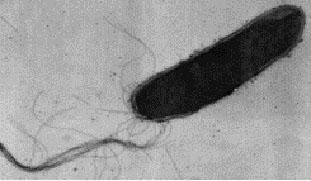|
| About ISB |
| Systems Biology |
Halobacterium |
| Labs Completed |
| About the Interns |
| Past Interns |
| Halo Group |
| Bacteriorhodopsin |
| Funky Fremont |
| Educators |
|
|||||||||||||
|
|
||||||||||||
Halobacterium is an “extremophile,” or an organism that thrives in harsh conditions. As a single-celled, rod-shaped microorganism, Halobacteria grow optimally in extremely high saline environments with water readily available, as demonstrated by their abundance in salt evaporation ponds and natural salt lakes such as the Dead Sea and the Great Salt Lakes. In addition to an ability to survive in conditions up to four times more saline than that of the sea, the Halobacterium also displays various other qualities that stimulated intense scientific interest. Besides its ability to resist fairly high levels of radiation without any significant structural damage, Halobacterium can also repair its own damaged DNA structures. This characteristic, if adapted, could potentially be the cure to various diseases that are results of deformities in genetic material. Unlike some of its close relatives, Halobacterium will grow under both aerobic and anaerobic conditions. In usual conditions, Halobacteria rely upon bacteriorhodopsin, a light-harvesting protein, to provide chemical energy for the cell. As the retinal molecule located in the center of each bacteriorhodopsin absorbs a photon of light, a series of reactions causes an isomerization in its carbon chain, resulting in the transfer of one single proton across the lipid membrane. This reaction in turn provides energy for the cell to create ATP and carry out its metabolic processes. However, if the microorganism is deprived of its light source, it can also rely upon the fermentation of arginine in order to obtain energy. Though it resembles some bacteria in shape, size, and general structure, the genetic makeup of Halobacteria differs from the genetic makeup of bacteria. In fact, various components of Halobacteria appear to be more closely related to those of eukaryotes than to those of bacteria, a fellow prokaryote. Thus, Halobacteria are placed in an entirely different domain: the Archaea. |
|||||||||||||
 |
WWW 2006 Intern Site |

